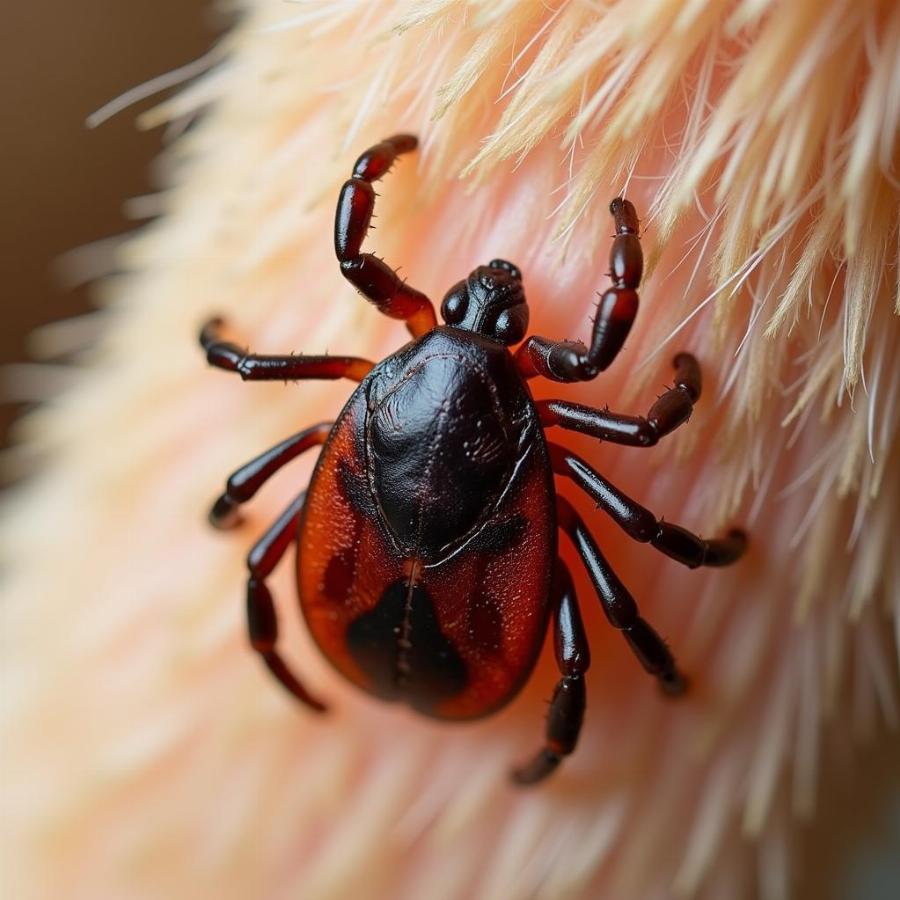Spotting a tick on your furry friend can be alarming, and rightfully so. These tiny parasites are more than just a nuisance; they can transmit dangerous diseases to our canine companions. While you may be eager to identify a tick bite, relying solely on pictures can be tricky. This article will guide you through recognizing tick bites on dogs, understanding the risks, and most importantly, what steps to take for prevention and treatment.
Identifying a Tick Bite: Beyond the Pictures
 Tick Attached to Dog's Skin
Tick Attached to Dog's Skin
While searching for “pictures of tick bites on dogs” is a natural reaction, recognizing a tick bite goes beyond a single image. Here’s what to look for:
- Finding the Tick: The most obvious sign is finding a tick attached to your dog. Ticks can vary in size and color depending on their species and how much blood they’ve consumed.
- Redness and Irritation: Tick bites often cause localized redness and inflammation at the bite site. The area may appear as a small, red bump, similar to a mosquito bite.
- Swelling: Depending on your dog’s sensitivity and the type of tick, you might notice varying degrees of swelling around the bite area.
- Scratching and Biting: Dogs often scratch or bite at areas irritated by tick bites. Excessive licking or chewing at a particular spot can be a telltale sign.
The Hidden Dangers: Tick-Borne Diseases
Ticks are notorious carriers of diseases that can have serious health implications for your dog. Some common tick-borne illnesses include:
- Lyme Disease
- Ehrlichiosis
- Anaplasmosis
- Rocky Mountain Spotted Fever
Symptoms of these diseases can vary but may include fever, lethargy, loss of appetite, lameness, swollen joints, and neurological problems.
Don’t Rely on Pictures Alone: Consult Your Vet
While online resources can be helpful, it’s crucial to remember that accurately diagnosing a tick bite and ruling out other skin conditions requires a veterinarian’s expertise. If you suspect a tick bite, schedule an appointment immediately. Your vet can properly identify the tick, assess your dog’s risk for disease transmission, and recommend the most appropriate course of action.
Prevention is Key: Safeguarding Your Dog from Ticks
Protecting your dog from ticks is a year-round responsibility, especially if you live in an area with a high tick population. Implement these preventive measures:
- Tick Control Products: Consult your veterinarian about the best tick prevention medication for your dog. Options include oral medications, topical treatments, and special collars.
- Regular Checks: After walks or playtime in wooded or grassy areas, thoroughly examine your dog for ticks, paying close attention to areas like the head, ears, neck, armpits, groin, and between the toes.
- Keep Your Yard Maintained: Regularly mow your lawn, trim bushes, and clear away leaf litter where ticks like to hide. Consider creating a tick-free barrier around your property using gravel or wood chips.
- Vaccinations: Talk to your vet about vaccinations available for certain tick-borne diseases, such as Lyme disease.
Removing a Tick Safely: The Do’s and Don’ts
If you find a tick on your dog, it’s important to remove it promptly and correctly to minimize the risk of disease transmission. Follow these steps:
Do:
- Use fine-tipped tweezers to grasp the tick as close to the skin’s surface as possible.
- Pull upward with steady, even pressure. Avoid twisting or jerking the tick, as this can cause mouthparts to break off and remain embedded in the skin.
- Clean the bite area with rubbing alcohol or antiseptic wipes.
- Dispose of the tick by placing it in rubbing alcohol, sealing it in a bag, or flushing it down the toilet.
Don’t:
- Use your bare hands to remove a tick.
- Try to burn the tick off or suffocate it with petroleum jelly. These methods are ineffective and can increase the risk of disease transmission.
Beyond Pictures: Staying Informed is the Best Defense
While “pictures of tick bites on dogs” can provide some visual guidance, understanding the nuances of tick identification, the risks associated with tick-borne diseases, and proactive prevention strategies are essential for every dog owner. By staying informed and taking the necessary precautions, you can help keep your beloved companion safe from these potentially dangerous parasites.
FAQs: Common Questions About Tick Bites on Dogs
1. Can I get a tick bite from my dog?
Yes, ticks can transmit diseases to humans as well. If you remove a tick from your dog, be sure to wash your hands thoroughly and monitor yourself for any unusual symptoms.
2. What should I do if I can’t remove the tick entirely?
If you’re unable to remove the tick safely or if any part of it remains embedded in the skin, contact your veterinarian immediately. They have specialized tools to ensure complete removal.
3. How long after a tick bite will my dog show symptoms of illness?
The incubation period for tick-borne diseases can vary but is typically within a few weeks to months after a bite. It’s essential to monitor your dog closely for any changes in behavior or health, even if the tick was removed promptly.
Looking for More Information?
For further insights on tick prevention, common canine health concerns, and expert advice on all things dog-related, explore the wealth of resources available on Beaut Dogs. We’re dedicated to providing dog lovers with the knowledge and support they need to keep their furry companions happy and healthy.
Beaut Dogs is your go-to source for reliable and insightful information on the wonderful world of dogs. When you need support, please contact Email: [email protected] to get detailed and accurate answers from Beaut Dogs.